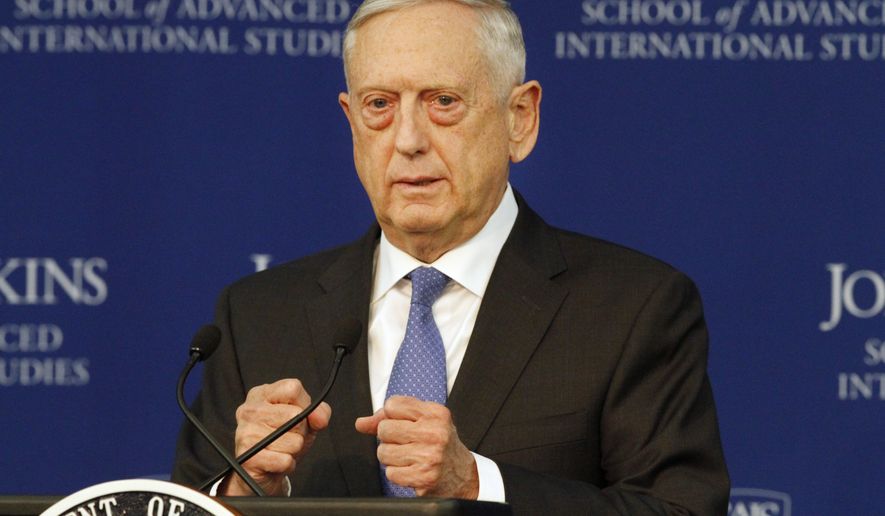Pentagon war planners are shifting away from the George W. Bush and Obama-era strategies dominated by battling extremist groups such as al Qaeda, the Taliban and Islamic State, and setting their sights on the growing military threat posed by Russia, China and other nation states.
Defense Department and national security officials within the Trump administration outlined this doctrinal shift in its new National Security Strategy (NDS), released Friday. Defense Secretary James Mattis made the case for the administration’s divergence from extremist terror threats to those posed by global powers during a speech Friday in Washington.
“We face growing threats from revisionist powers as different as China and Russia. Nations that seek to create a world consistent with their authoritarian models,” Mr. Mattis said during his speech at the Johns Hopkins School for Advanced International Studies.
Noting the development of the NDS required “tough choices” to be made by defense and national security leaders, Mr. Mattis said the end product “makes a clear-eyed appraisal of our security environment, with a keen eye on America’s place in the world.”
Those tough choices, he noted, were made “based on a fundamental precept: That America can afford survival.”
Specifically, the defense strategy contends Beijing though “military modernization, influence operations and predatory economics” is pursuing its own designs to replace the U.S. as the premier regional power in the Indo-Pacific region. China has already drawn the ire of Washington and its Pacific allies through its aggressive actions in the South China Sea and continued backing of the rogue regime in North Korea.
On Russia, Pentagon analysts suggest Moscow is seeking to “shatter [NATO]and change European and Middle East security and economic structures to its favor.” Russian influence campaign and shadow military operations in Ukraine and the Baltic states, its backing of government forces in Syria and cooperation with Iranian-backed militias in the country are widely seen as evidence of Moscow’s intentions.
Such claims simply represent Washington’s recognition “that China and Russia, in particular, have been assiduously working over a number of years to develop the military capabilities to challenge our military advantages,’ Elbridge Colby, the deputy assistant secretary of defense for strategy and force development, told reporters Thursday at the Pentagon.
The release of the new Pentagon strategy was met with praise from defense analysts and international partners.
“The National Defense Strategy released today by Secretary Mattis is extraordinarily significant in a number of ways, and there is much to like in it,” retired Lt. Gen. Thomas Spoehr, director of the conservative Heritage Foundation’s Center for National Defense, said in a statement Friday. “It is more candid and forthright in describing the potential adversaries the U.S. faces, as well as the current state of the U.S. military.”
UK Defence Secretary Gavin Williamson also welcomed the new outlook presented within the defense strategy, saying the “the document provides a useful lens and framework on which to focus joint and allied activities.”
The strategy’s “assessment of today’s geopolitical strategic landscape, the Ministry of Defence recognizes a familiar world view and the need to generate a whole-of-government response,” Mr. Williamson said, noting the Pentagon plan “strongly reaffirms the continued centrality of key Allies in preserving, maintaining and expanding a free and open international order.”
The renewed focus on nation-state adversaries will likely drive Pentagon investment toward more conventional weapon systems and programs like warships, fighter jets, tanks and heavy artillery, as opposed to unmanned drones and other systems closely associated with the war on terrorism.
Army Chief of Staff Gen. Mark Milley said this week his forces needed to invest in the weapons and capabilities designed to fight “the big war” rather than the small, low-level conflicts that have characterized the post 9/11 era.
“We have to modernize ourselves against that type of capability” posed by nations like China and Russia, the four-star general said during an Association of the U.S. Army breakfast in Virginia.
“We need to pick our game up and pick our pace up and especially, in the United States and the United States Army. To do that … we need significant improvements” in conventional war-fighting skills and capabilities, he added.
But the call for more investment in traditional war-fighting capabilities in the new strategy is not loud enough, Gen. Spoehr said, noting the plan’s focus to deter major, nation-state adversaries while only curbing other threats such as terrorism “sets too low a strategic goal” for American and allied forces.
Back at the Pentagon, Mr. Colby was quick to point out the department’s renewed focus on conventional warfare did not mean U.S. military planners were abandoning its interests in containing extremist groups such as al Qaeda and the Islamic State, also known as ISIS. The new strategy, however, will see the U.S. depend heavily on local, proxy forces to keep the peace in places like North Africa and the Middle East.
That said, department war planners will look to increase its military adviser efforts, which saw great success on the battlefields of Iraq, Syria and Afghanistan, to ensure local security forces have the wherewithal to keep extremism in check, according to the new strategy.
“[We’ve] been dealing with the terrorism problem and the rogue state problem for a long time … but we really do need to focus on these very, very tough major power potential challenges,” Mr. Colby said.
• Carlo Muñoz can be reached at cmunoz@washingtontimes.com.




Please read our comment policy before commenting.